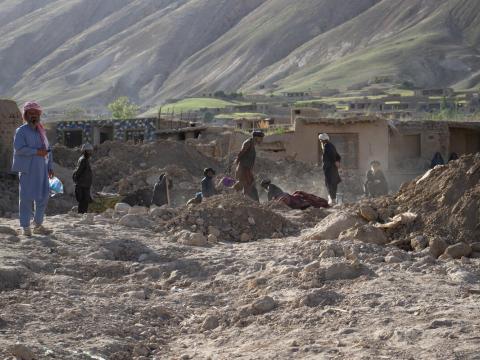Climate, conflict and hunger create spiralling crisis for world’s most vulnerable

- Nearly 90% of people interviewed see climate change as a serious threat to their communities
- More than 60% of people said climate shocks are creating more conflict in their communities. In Syria and Afghanistan, the figure was above 90%.
- Climate impacts, hunger and conflict are inextricably linked; people who said climate hazards were making it difficult for them to access water or food were 27% more likely to have witnessed conflict and those who had seen pastureland reduced were 32% more likely.
- Almost 60% of respondents indicated that climate change is displacing people either from or to their communities, demonstrating how environmental pressures are driving migration and potentially fuelling local tensions.
Climate change is deepening hunger and fuelling conflict in some of the world's most fragile regions, according to a new report released ahead of Earth Day by international aid organisation World Vision.
The report, “Triple Threat: Climate change, conflict, and hunger endangering children’s lives” shows that climate change is contributing to hunger in 12 fragile countries—including Afghanistan, Somalia, Syria, and the Central American Dry Corridor. Climate-driven disasters such as drought, floods, and heatwaves are intensifying resource scarcity and social tensions, triggering displacement and worsening hunger and conflict.
Nearly 90% of surveyed communities say climate change poses a serious threat, with over 80% directly linking climate shocks to increased food insecurity. Particularly alarming, communities in Afghanistan and Syria report near-universal experiences of drought and water scarcity exacerbating local conflicts. The greater the climate impacts on a family’s food security, the higher their risk of experiencing conflict.
“Failure to take care of God’s creation has left the world’s most vulnerable children facing a dire situation,” says Amanda Rives, Senior Director, Disaster Management at World Vision International. “The combined effects of violence, climate change and hunger are intersecting in alarming ways, trapping vulnerable children and their families in a vicious cycle. We need urgent, coordinated global action to prevent millions more from slipping into devastating cycles of hunger and conflict.”
The report highlights severe underfunding for climate adaptation in conflict-affected countries, with nations like Somalia receiving less than 1% of the climate financing required.[1] This leaves the most vulnerable communities unable to cope with increasingly severe climate impacts.
“As we mark Earth Day, this report is a sobering reminder that climate change is not just an environmental issue—it’s a human crisis impacting lives, livelihoods, and futures. It’s imperative that the international community steps up to protect the world’s most vulnerable from these preventable tragedies,” Rives said.
Report available to download here
World Vision is a Christian humanitarian and development organisation dedicated to working with children, families and their communities to reach their full potential by tackling the root causes of poverty and injustice. World Vision and their partners are working in communities to improve families’ economic prospects, strength violence prevention and child protection services, and improve education systems.
World Vision serves all people, regardless of religion, race, ethnicity or gender. For more information, please visit www.wvi.org/emergencies/hunger-crisis or follow us on X (formerly Twitter) @WorldVision
About the report
More than 3,700 adults from 12 countries in Central America, South Asia, Oceania, Africa and the Middle East participated in quantitative surveys, key informant interviews, and focus group discussions about the ways in which climate hazards, conflict and hunger are affecting their lives. The survey was first administered in August 2023, and a slightly modified questionnaire was used in September 2024 for Syria, Afghanistan and Somalia, with the addition of several questions to measure shock exposure. We analysed whether community members thought climate change and the impacts of climate hazards actually contributed to an increased likelihood of experiencing conflict using basic tables, correlation and regression analysis.
Offices were selected for inclusion based on capacity, relevant exposure to climate, conflict, and hunger, and geographic spread. Each office identified a specific region within their country (or region, in the case of the Dry Corridor). Findings should thus not be generalised to the countries as a whole but only to the areas of interest, which were as follows: Ghor in Afghanistan, Centre Est in Burkina Faso, Haut Katanga and Lualaba in the Democratic Republic of Congo (DRC),[2] Anbar in Iraq, Bougainville in Papua New Guinea (PNG), Galmadug in Somalia, Northern Syria, and Puttalam in Sri Lanka. Findings from a range of urban, rural, and indigenous communities in El Salvador, Guatemala, Honduras, and Nicaragua are grouped as the Dry Corridor.
[1] Gulati, M. ODI. (2023). What the case of Somalia can show us about financing climate action in conflict-affected countries.
[2] The historical province of Katanga was divided into four new provinces in 2015; two of which (Lualaba and Haut Katanga) were included in the research. However sometimes in the report we refer to ‘Grand Katanga’ for ease of reference.